The Volpin Project, Part 15: The Lessons Learned
As someone who is largely self taught in the practice of prop building, I learn new lessons with nearly every project. In the case of something insanely complicated like the Halo Needler, I learn a ton of new things. This final entry into the Needler build log will be all about tips and tricks that emerged from this project, which hopefully will help other propmakers in the future!
As someone who is largely self taught in the practice of prop building (and its associated skills of airbrushing, moldmaking, casting, and simple electronics) I learn new lessons with nearly every project. In the case of something insanely complicated like the Halo Needler, I learn a lot of new things. Some of this newfound knowledge comes from screw-ups and some from pretty happy accidents that work in my favor. This final entry into the Needler build log will be all about tips and tricks that emerged from this project, so hopefully anyone looking to emulate this process can avoid similar pitfalls.
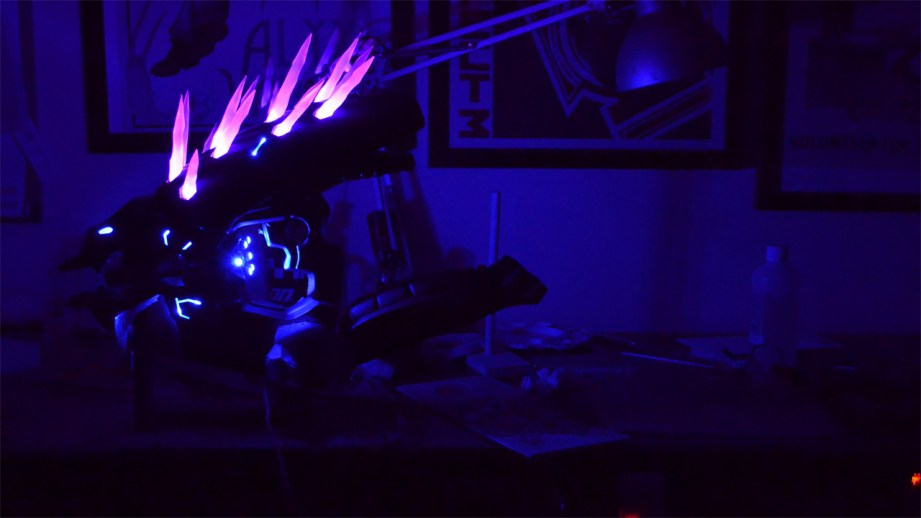
Let’s go over the lessons learned in chronological order.
Medium Density Fiberboard vs. Styrene Frames
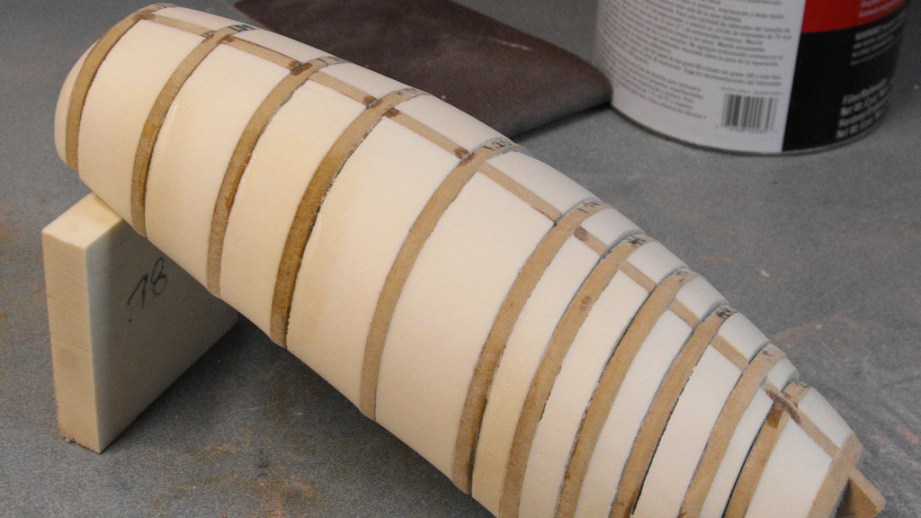
First off, the MDF ribbed sculpting system I put together (as seen above) worked pretty darn well. There can be issues with the MDF ribs if you don’t take care to make sure your shop is a constant temperature and humidity, as the wood will swell and shrink causing the surface of your part to change in frustrating ways as well. The urethane foam here worked wonders as well, though I’d go with a harder density in the future to make the shaping a bit more smooth and possibly use less bondo fixing over-sanding issues.
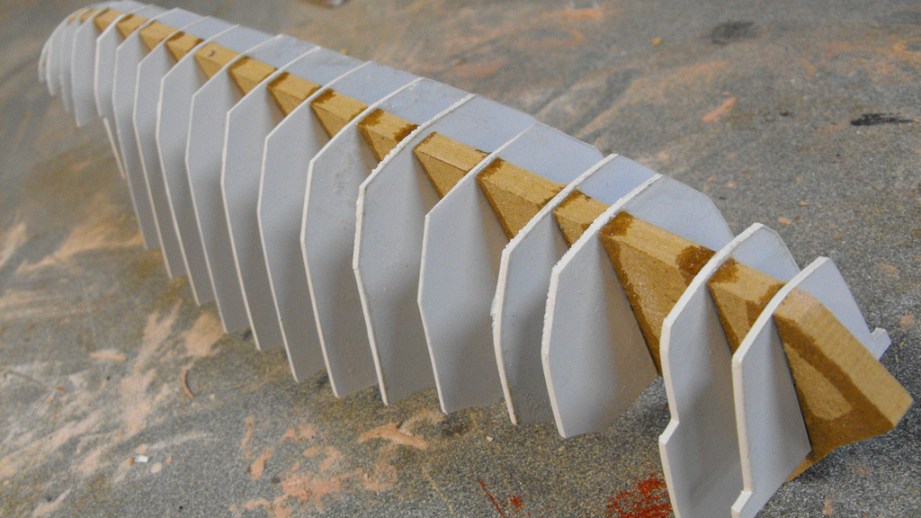
This styrene rib method, however, was mostly useless for building. The styrene ribs were far denser than the surrounding foam or bondo filler that came later, and any time one of them came near the surface of the piece it would create a high spot where the softer material on either side would sand unevenly.

I eventually took a grinding wheel to all of the ribs and skimmed over them with filler, but that took way too much time to correct and I would have been better off sticking with MDF.
Complex Geometry is a Challenge
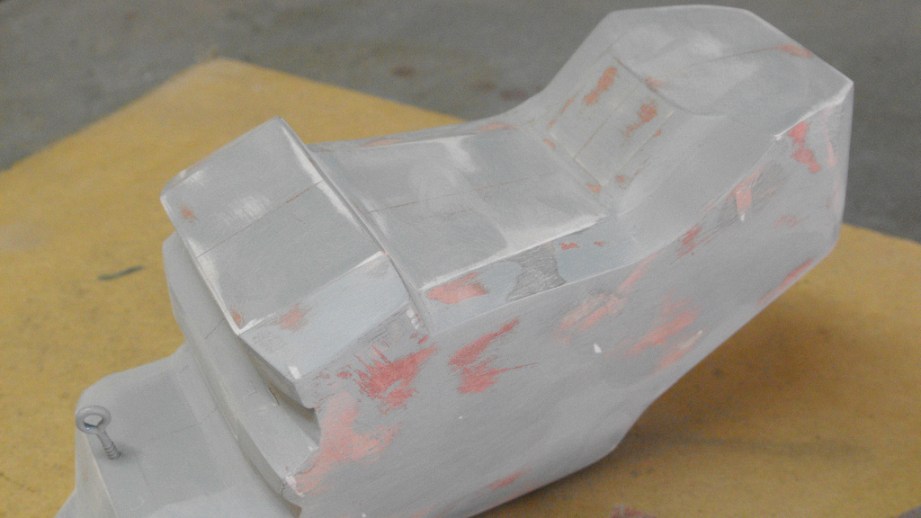
Parts like the one above are a CG weapon designer’s way of saying “I dare you to try to make this silly thing.” I didn’t learn much from sculpting this piece but I just wanted to call out the absolutely maddening geometry on the front of the piece. I got to know my Needler schematics very intimately while shaping this particular piece.
Laser Line Alternative
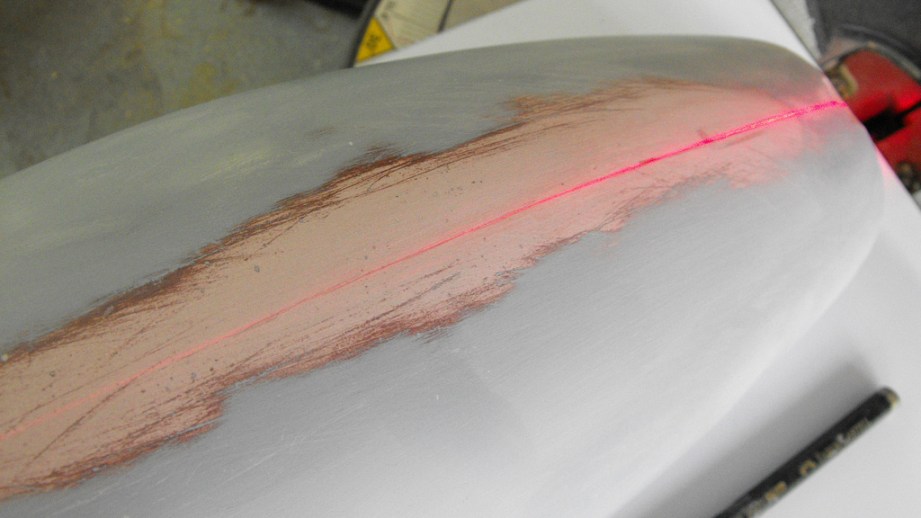
Don’t have a laser line or level? Use the guides on your chop saw to find the center! Really, a laser line would have just been a $15 trip to the hardware store, but don’t knock what works when you’re on a deadline.
PVC Piping and Endcaps for Fitting
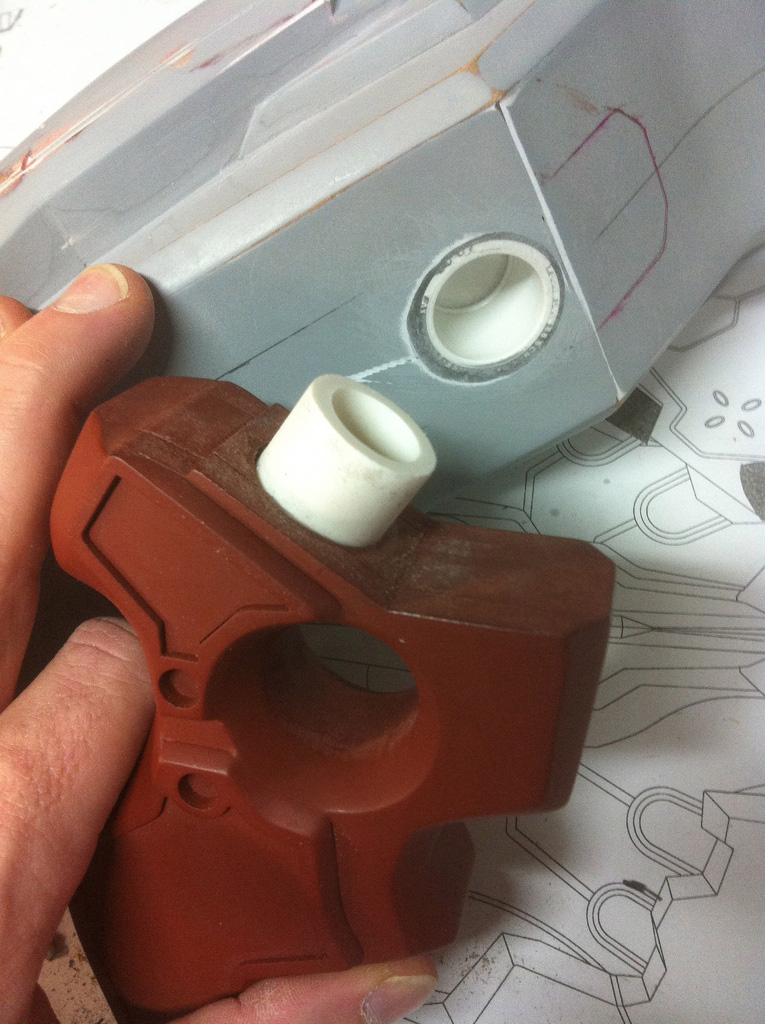
This is the first project I’ve created where all of the associated parts fit together with prominent mounting pegs or slots. Some of these were a hassle to create, but I eventually honed in on a readily available and rock solid solution. ½” PVC endcaps and pipe were used on many intersecting parts to make assembly faster and more rigid. This sped up the final build process considerably, and also allowed me to make dozens of fitment checks and mockups during construction.
Ping Pong Balls Are a Spherical Mess
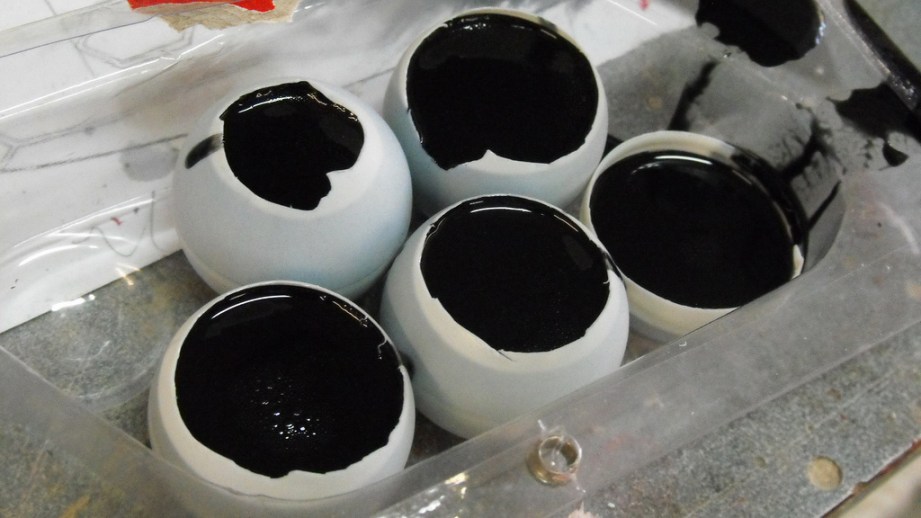
Ping Pong balls stink when you cut them open, and apparently the plastic they’re made from is highly flammable and toxic when sanded or melted. Still, they’re a very quick solution when you need some fancy sphere-type shapes on a complex part.
Let Primer Coats Cure Properly
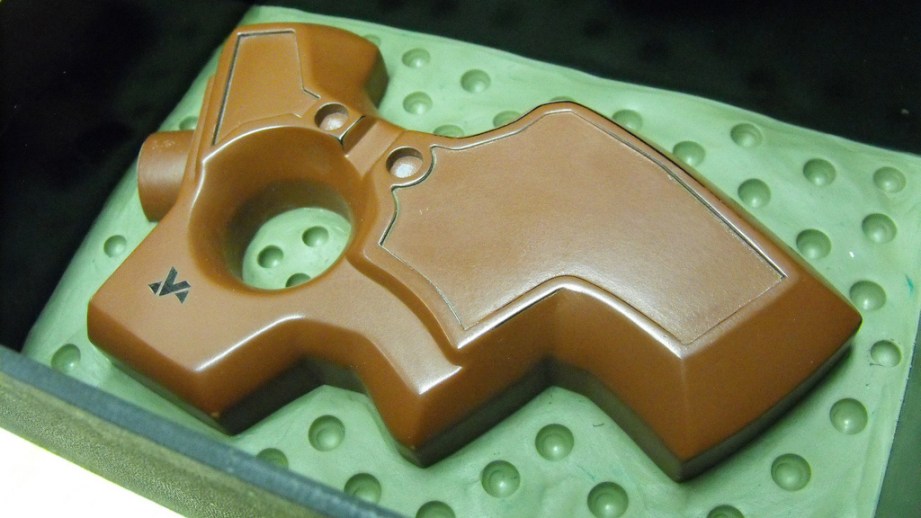
[Speaking to myself here] Hey, genius. You should know this already, but since you’re in such a rush maybe you need to waste a few ounces of expensive silicone in order to get the message. Let the primer coat on your parts cure for at least 24 hours before attempting to mold them. Off gassing from primer will inhibit platinum cure silicone.
Test Your New Materials
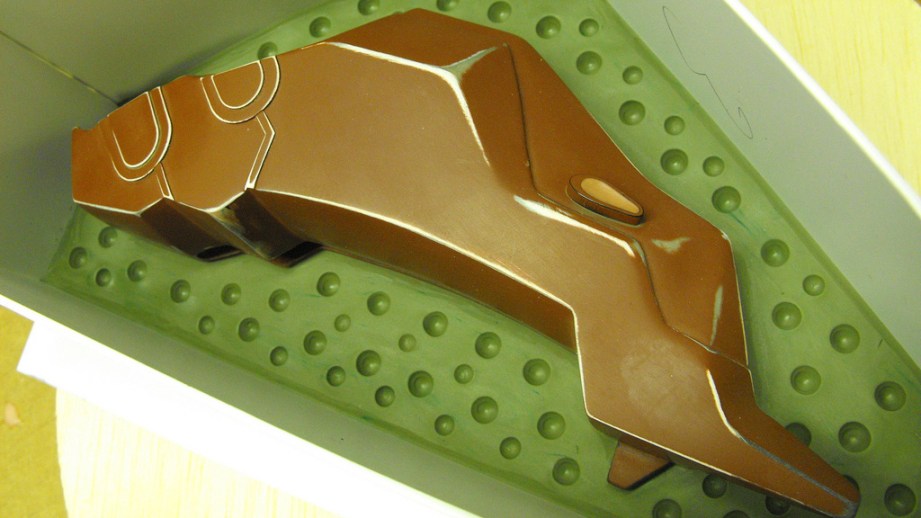
While we’re on the subject, test out new materials before going all in. The green clay in this photo has been used many times in the past without incident, but the small blob of orange toward the front of the part hasn’t been tried with the silicone I chose to use on this project. Turns out it keeps the silicone from curing, which I only learned after pouring the first half of three molds. For those looking for more tech specs, that’s Chavant NSP medium clay and Smooth-On’s Mold Star 30. They don’t like each other.
The Bondo Squish!
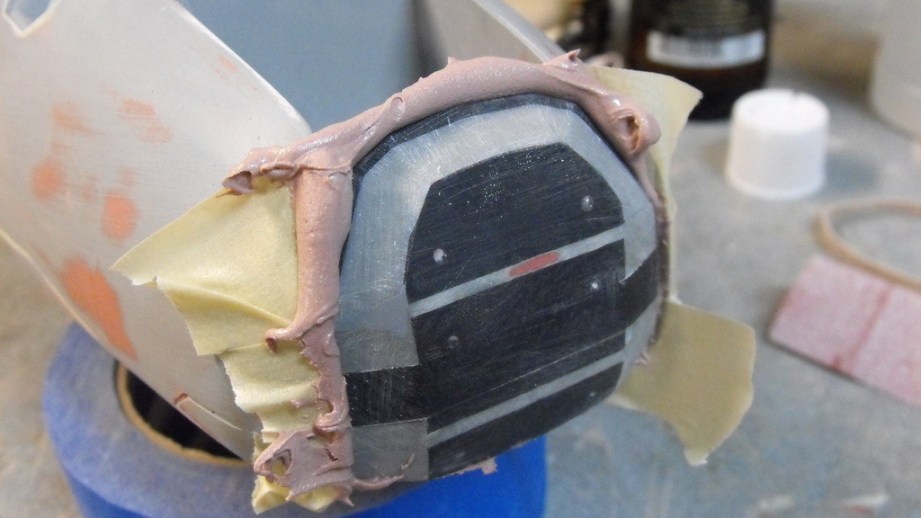
Blatantly stolen from my friend Bill Doran over at Punished Props, the “Bondo Squish” method allowed me to get many parts to mesh together with exacting tolerances. Just tape over one part, apply wax or mold release, slather with bondo, then squish the parts together. Once the bondo is partly cured (rigid but you can dig your fingernail into it) pop the outer piece loose and trim up the overflow.
Take Care with Pressure Casting
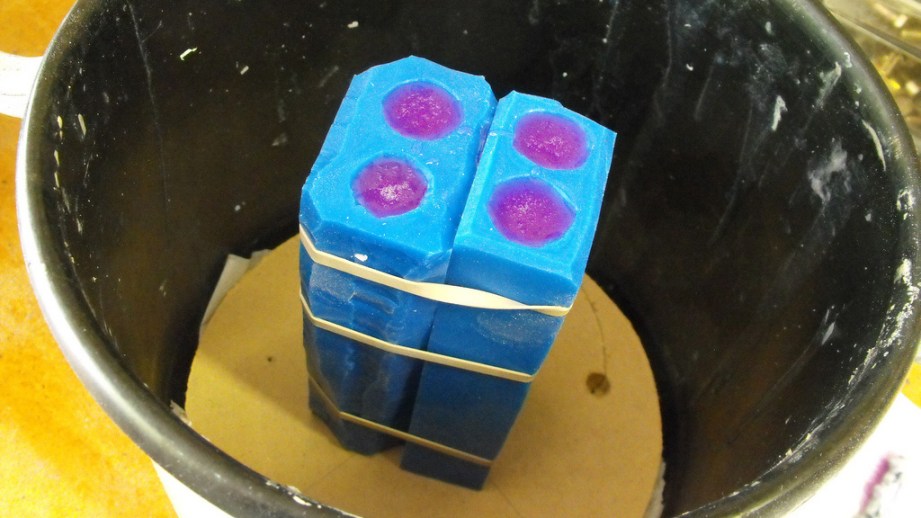
Pressure casting was a new world for me with this project, and I will say I got very lucky with the pieces I made. A lot of people have frustrating hang ups with clear resin and this can lead to parts that never dry or are cloudy from humidity and heat. If you go the route I did with Smooth-On’s “Crystal Clear,” make sure to read the datasheet about part thickness. By using the proper “202” series resin, I got clean pulls every time.
Strong Dye is Strong
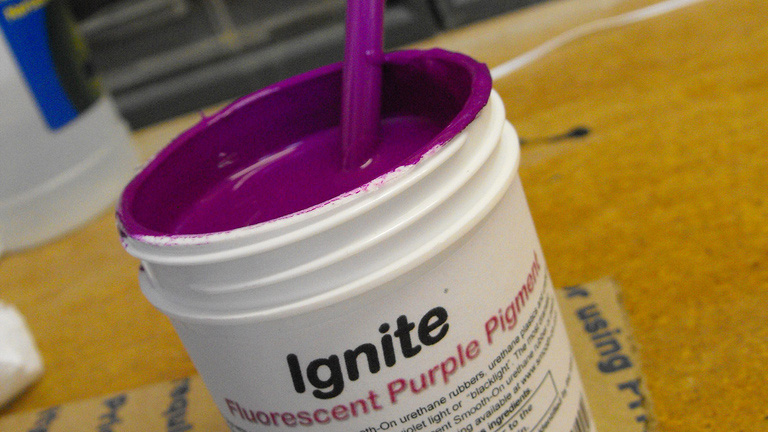
Two drops of this stuff was enough to tint four needles. This is the strongest resin dye I’ve ever used, and judging by how sparingly it should be applied, I’ll have a large amount of it for a long time.
Dusting Your Molds
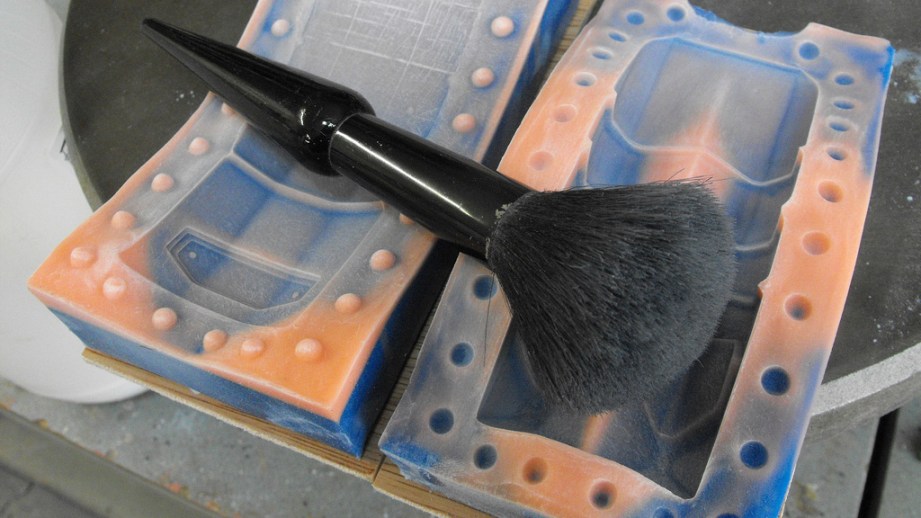
Remember when I talked about dusting your molds in order to get better pulls? I ran out of baby powder one time and substituted cabosil in its place. Cabosil is a thickening filler for resins that (depending on the amount used) changes consistency from water thin right up to cake icing and everywhere in between. Apparently it also bonds to silicone when applied directly, pulling moisture out of the mold and damaging it quite severely once resin is poured in, effectively fusing the urethane to the mold material. Whoops.
Fun with Sparkfun
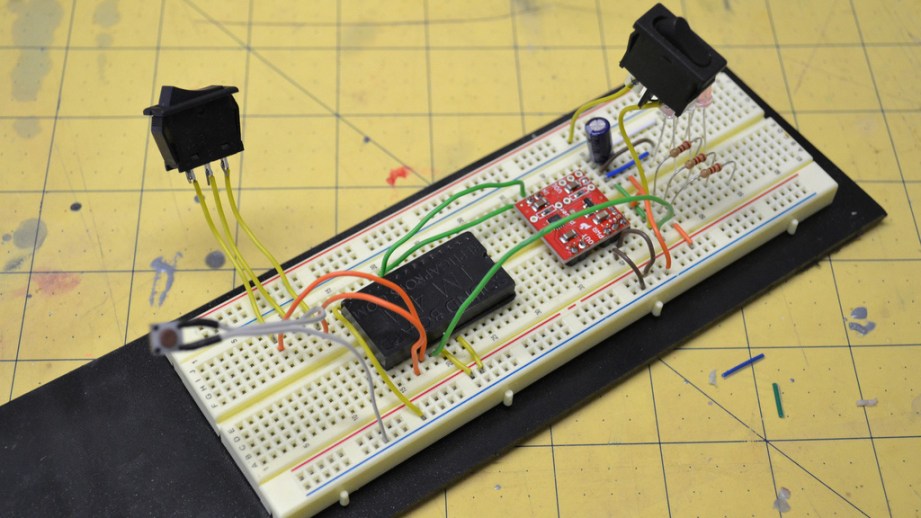
The little mono amplifier from Sparkfun (the red chip on the breadboard there) made all the difference in the world when it came to the sound effects. I’ve put audio electronics in props before but the speakers have been run directly off the sound chip. For something like a static display ship model where you only want a gentile engine hum this would be fine, but adding an amplifier to the circuit gives the Needler firing noises some much needed oomph.
Magnetically Attached Battery Covers
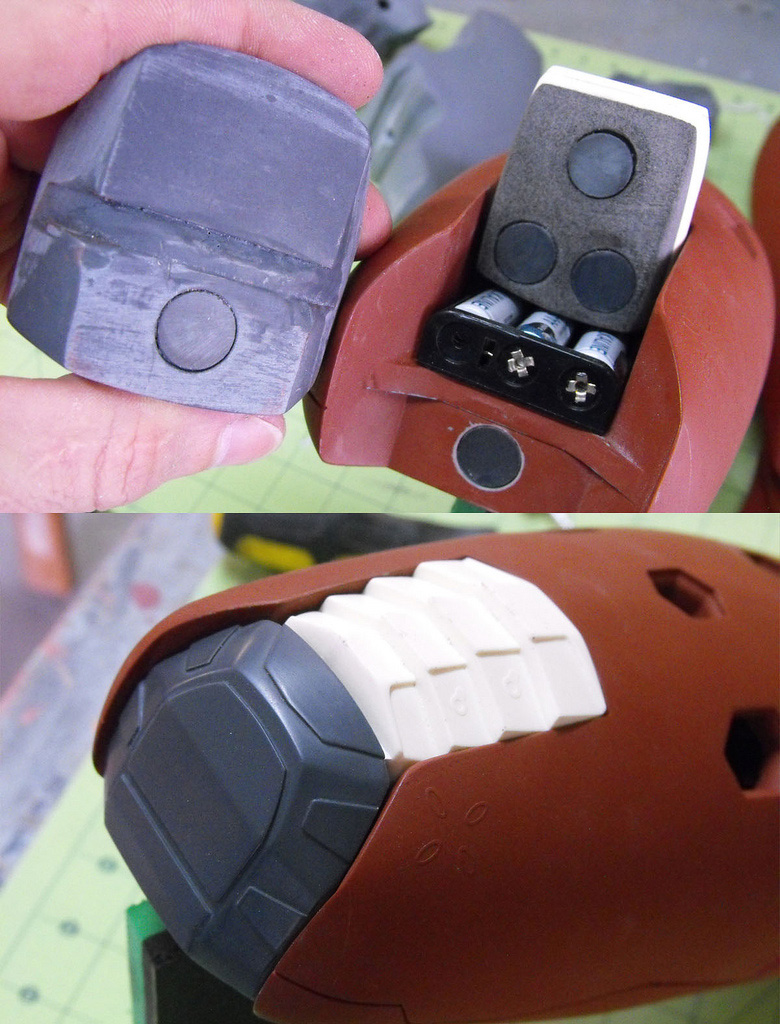
Magnets are awesome. I need to do more stuff like this in future projects instead of trying to blend in pre-existing battery covers and the like.
Test Your Paint on Scraps First
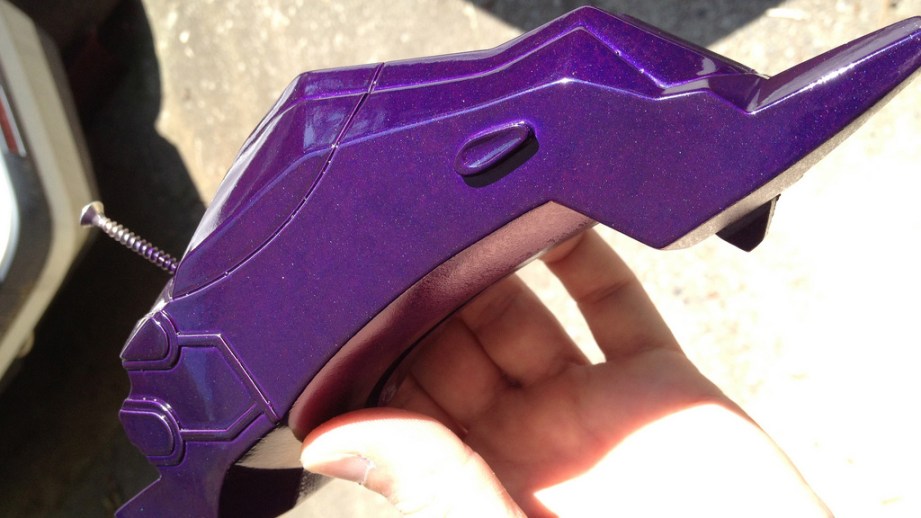
I actually learned this tip a long time ago and remember it well, but it’s a good one so it bears repeating. Test your paint first on scrap parts. Unless you’ve used these exact paints on these exact materials in these exact weather conditions before, something bad is inevitably going to happen. I had 5 or so scrap test pieces that were used before I settled on a mix of purple that I felt looked best, and I actually went through 6 shades/brands of paint before selecting the one I wanted to use. On a related topic, I also now have 5 bottles of purple paint I don’t like and don’t know what to do with.
Getting That Metal Texture
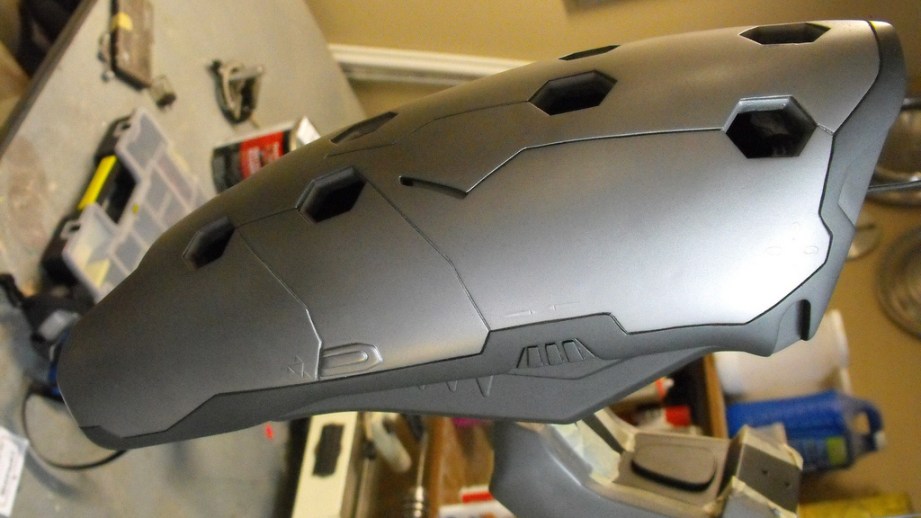
Testor’s buffable metalizer makes for a great undercoat for metallic shades. It’s a lacquer, so be careful what you spray it on top of since lacquers can pull up enamel base coats. The paint can pick up the texture of masking tape if you need to tape off sections to get any sort of dual color look, so you should seal it with clear between coats to avoid this. It’s extremely fragile until clear coated and takes a special Testor’s clear in order to keep its metallic shine.
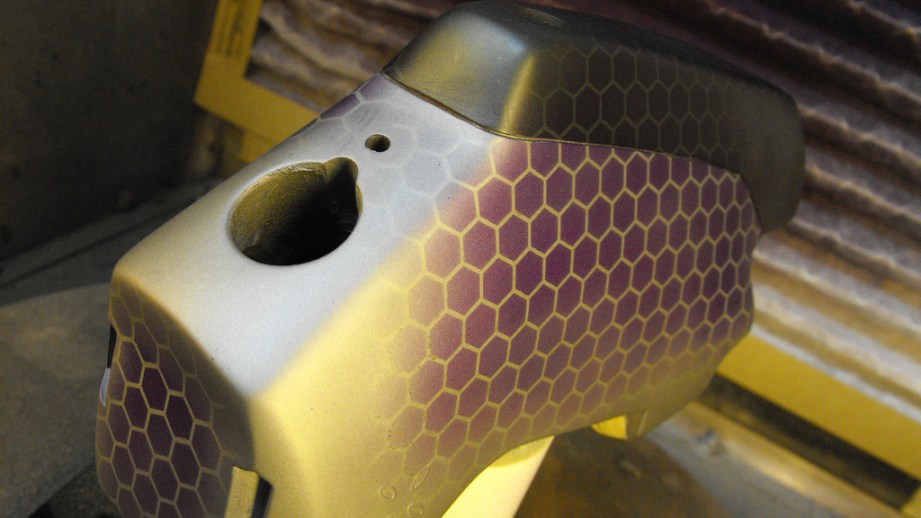
Speaking of its fragility, you can see in the foreground of this shot where the mask has pulled some of the metalizer paint off the surface. This part had a darker coat sprayed first, then it was masked for the lighter silver. The small dots are where the light silver has chipped away revealing the darker coat beneath. This wasn’t an issue for me since the whole thing got a thick coat of purple after this shot was taken, but if you’re going to mask off Testor’s metalizer make sure to use something low tack. The vinyl here was just too adhesive.
Hacking a Spray Can
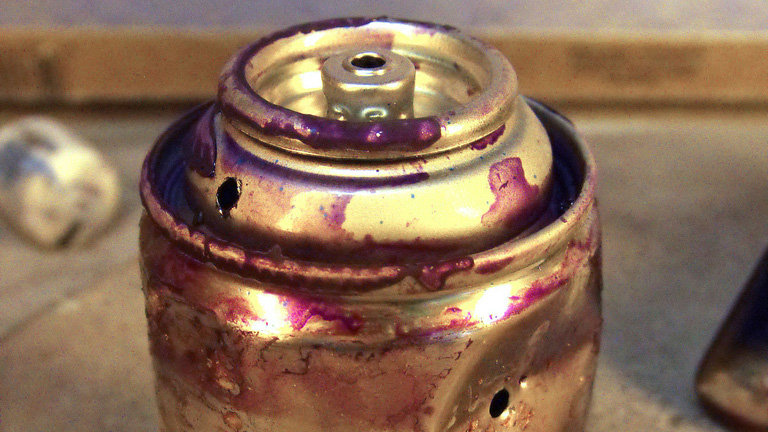
Spray cans kind of suck, especially for clear coats and fine detail. This is an old trick that many people probably know, but for those that don’t, here ya go: Flip your can upside down and stick a clamp on it to hold the nozzle down. This will release all the propellant over time, leaving you with a can of unpressurized paint. Drill two holes in it (one to pour and one to vent while pouring) then dump the paint into a sealed glass container for storage. Now you can mix that shade of paint with any other you’d like and use it in a far more precise airbrush!
IMPORTANT: DO NOT DRILL INTO A PRESSURIZED CAN. I don’t want to have to say that but it’s the internet and I’d rather not be responsible for someone losing an eye or something.
Laser Cut Masking Tape Stencils
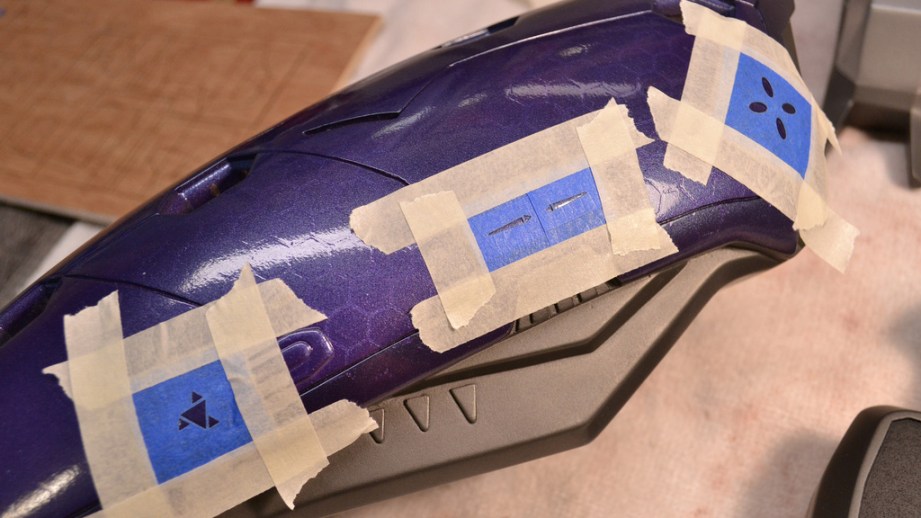
Did you know laser cut masking tape makes for pretty good stencils? You did? Well I didn’t, smarty pants, so it was exciting for me to find out.
For the Love of Airbrushing
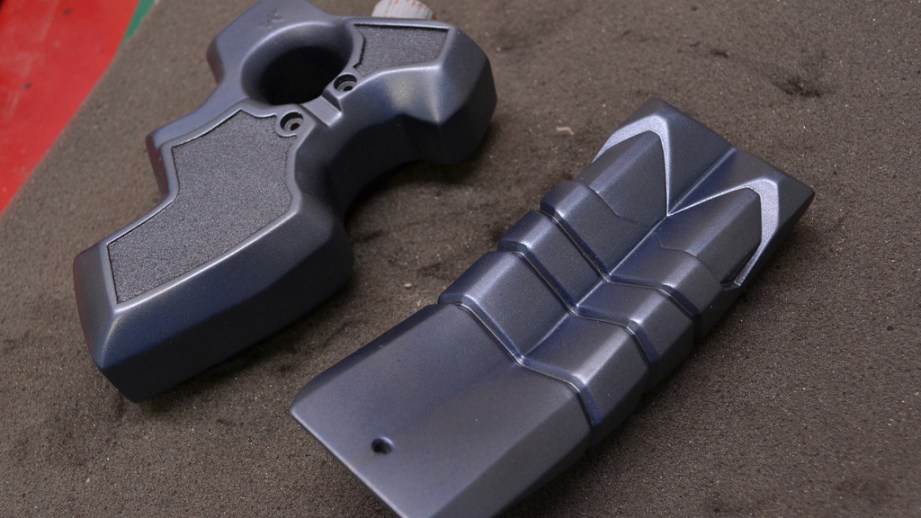
I really got to know my airbrushes a lot better over the course of this project. The parts here have a metallic silver base coat followed by a thinned metallic blue clear. The blue was a metallic brush paint thinned with airbrush medium and matter clearcoat in a 1:2:4 ratio. Prior to this I relied a lot on spray cans for the colors I was after, but the Needler necessitated a lot of custom mixing. I have two airbrushes, an Iwata Eclipse HP-BCS and a Thayer & Chandler from the mid 60’s.
Build Assembly Jigs
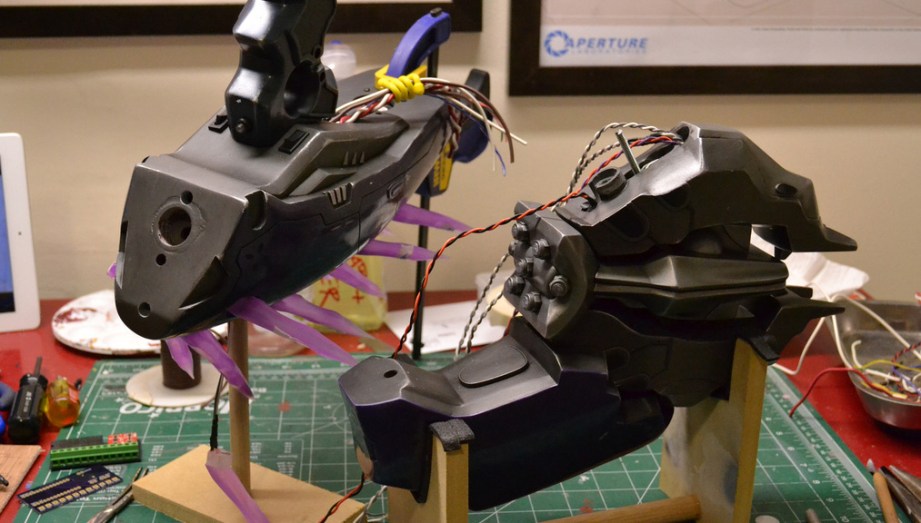
Assembly jigs are the best thing ever. I don’t know why I never had the idea to do this before, but being able to put together an unwieldy shape without having to balance it between your knees or on a precarious pile of workbench flotsam makes the assembly process so much easier. It only take a few minutes to hack together a rigid jig but it will save hours in frustration.
I know people are chomping at the bit to see shots of the final project, and they’ll be here soon (after Dragon*Con!). I hope this last build entry was educational and hopefully you, dear reader, can avoid some of the headaches that kept me awake at night!
The Volpin Project, Part 1: Introductions
The Volpin Project, Part 2: References and Blueprinting
The Volpin Project, Part 3: Selecting Materials
The Volpin Project, Part 4: Taking Shapes
The Volpin Project, Part 5: Bondo Strikes Back
The Volpin Project, Part 6: Details, Accents, Refinements, and Mockups
The Volpin Project, Part 7: Introduction to Moldmaking
The Volpin Project, Part 8: More Complex Moldmaking
The Volpin Project, Part 9: The Casting Process
The Volpin Project, Part 10: Illumination and Audio
The Volpin Project, Part 11: Prepping for Paint
The Volpin Project, Part 12: Finally Time to Paint
The Volpin Project, Part 13: Weathering The Needler
The Volpin Project, Part 14: Putting It All Together
4 thoughts on “The Volpin Project, Part 15: The Lessons Learned”
Leave a Reply

One Day Builds
Adam Savage’s One Day Builds: Life-Size Velocirapt…
Adam embarks on one of his most ambitious builds yet: fulfil…

Show And Tell
Adam Savage’s King George Costume!
Adam recently completed a build of the royal St. Edwards cro…
All Eyes On Perserverance – This is Only a Test 58…
We get excited for the Perserverance rover Mars landing happening later today in this week's episode. Jeremy finally watches In and Of Itself, we get hyped for The Last of Us casting, and try to deciper the new Chevy Bolt announcements. Plus, Kishore gets a Pelaton and we wrack our brains around reverse engineering the source code to GTA …

One Day Builds
Mandalorian Blaster Prop Replica Kit Assembly!
Adam and Norm assemble a beautifully machined replica prop k…
House of MCU – This is Only a Test 586 – 2/11/21
The gang gets together to recap their favorite bits from this past weekend's Superb Owl, including the new camera tech used for the broadcast and the best chicken wing recipes. Kishore shares tips for streamlining your streaming services, and Will guests this week to dive into the mind-bending implications of the latest WandaVision episod…

One Day Builds
Adam Savage’s One Day Builds: Royal Crown of Engla…
One of the ways Adam has been getting through lockdown has b…

Making
Adam Savage Tests the AIR Active Filtration Helmet…
Adam unboxes and performs a quick test of this novel new hel…

Making
Weta Workshop’s 3D-Printed Giant Eyeballs!
When Adam visited Weta Workshop early last year, he stopped …

One Day Builds
Adam Savage’s One Day Builds: Wire Storage Solutio…
Adam tackles a shop shelf build that he's been putting off f…

Show And Tell
Mechanical Dragonfly Automata Kit Build and Review
Time for a model kit build! This steampunk-inspired mechanic…


























The dusting molds thing is something I wanna try and have a few projects coming up that I know I will get a chance to try this out so I’m excited about it. How lame am I getting excited for dusting molds haha! Thanks for all the great info sir.
Awesome. This is a ton of good advice. It is always a thing, with a build project, that the little details and little tricks to ease the process save massive amounts of time and frustration in the end.
Man, it turned out SO well. Super inspiring.
I’ve quietly followed this series since its incarnation and I just wanted to say, this is some exceptional work. The building, documenting the process, photos, just everything. Superbly done and thanks for this =)